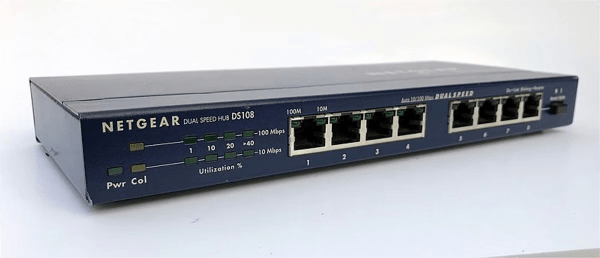Ethernet Hub vs. Switch: How to Choose?
Let’s compare Ethernet Hubs to Ethernet Switches. An Ethernet hub is a one-of-a-kind invention that serves as a hub for various systems to connect to a shared network. The actual connection occurs via a single network route and serves to connect various LAN segments.
A switch, on the other hand, is a specialized device that connects various systems over a single-link computer network. A switch, also known as a bridging device, is a device that aids in the routing of electronic data delivered over networks.
This article will explain the differences between Ethernet hubs and switches. Which Ethernet network device is best for you, and how do they differ? Let us seek answers to these important questions.
Contents
What does an Ethernet switch do?

What does an Ethernet switch do: A multi-port network bridge is what an Ethernet switch is commonly referred to as. This is due to the fact that it processes and routes data on the OSI model’s data link layer (layer 2) and, on occasion, the network layer (layer 3). In addition to a MAC address table, these layer 3 switches will have access to an IP routing table, which allows data to be routed through IP addresses assigned within the network.
The Ethernet Gigabit switch, as an intelligent device, transmits data to specific MAC addresses within the LAN. Furthermore, the switch can perform all the functions of a hub more efficiently, including recognizing the intended destination of the source information that they receive.
An Ethernet switch with access to a list of MAC addresses can send and receive data on specific devices connected to it. The benefit of MAC addresses is that they are always unique, reducing data traffic collisions and other issues.
How to use an Ethernet switch?
How to use Ethernet switch: The usage is essentially the same whether the switch is unmanaged or managed. It should first connect to the network and power supply. This section introduces the use of an Ethernet switch.
- Connect the modem to the Ethernet input line. The modem is the device that routes the signal through the network.
- Connect the router to the modem. The router converts the private network address into the public address, allowing all connected network devices to access the Internet.
- Connect an Ethernet cable to one of the switch’s ports, then to a wired device such as a computer. Repeat this step until all PCs, servers, laptops, and other Ethernet devices are connected.
- Connect an Ethernet cable to one of the switch’s backports, then connect the other end of the cable to one of the router’s backports. As a result, the switch functions as an extension of the router. You connect one output to your router, and the others simply split that connection to provide more hookups.
- Connect the supplied power adapter to the switch’s power port, then plug the other end into a power socket. If the switch is PoE, this step can be skipped.
- The unmanaged switch is now ready to use, whereas the managed switch may require additional adjustments via a supported method, such as a command line interface (accessed via secure shell, for example), a web interface loaded in your web browser, or Simple Network Management Protocol (SNMP) for remote access. This approach will open up new possibilities for traffic prioritization, such as port speed, virtual LANs, redundancy, port mirroring, and Quality of Service (QoS).
What does an Ethernet hub do?

What does Ethernet hub do: An Ethernet hub, also known as a network hub, is a simple networking device that provides multiple Ethernet ports to extend a network. It links multiple Ethernet devices on a single network. The data received or sent by the hub is not examined. It operates at the physical layer (layer 1) of the OSI model and requires no additional administration because its sole function is to copy and forward data to all clients (computers, printers, smart TVs, and so on) connected to the hub.
This means that if you try to send a message to one computer, the message will be received by all computers on the network. As you might expect, the disadvantage of using a hub is that there is no privacy within the network.
Because Ethernet hubs use simplified electronics and are easier to manufacture, they can be less expensive than network switches. However, because unmanaged switches are already relatively cheap, saving a few dollars on a hub and foregoing all the features of a switch is simply not worth it—unless you’re using a hub for other purposes!
How to use an Ethernet hub?
How to use an Ethernet hub: An Ethernet hub is one of many devices that can be used when expanding an existing computer network or building a new one. An Ethernet hub is a simple device that connects multiple computers and the rest of the network, enabling communication between all connected devices. When the enhanced functions of a router or the higher communications speed of a switch are not required, an Ethernet hub can be an efficient method for setting up or expanding a network at a lower cost compared to a router or switch.
- Connect your Ethernet hub to a power source.
- Connect your Ethernet devices to the hub using Ethernet cables.
- Connect the Ethernet hub to your router or modem using an Ethernet cable.
- Once all the connections have been made, power on the Ethernet hub and all devices connected to the hub.
- Check the connection. Use the “ping” command to check if each device is connected.
- Configure the devices connected to the hub.
- Your Ethernet hub should now be working, allowing your Ethernet devices to communicate with each other.
Ugreen Ethernet hub is a versatile and reliable networking device that allows you to connect multiple devices to your network through a single Ethernet port. With its compact and lightweight design, this hub is perfect for home or office use.

It supports high-speed data transfer rates of up to 1000Mbps, ensuring that your devices are connected at the fastest possible speeds. The hub also supports plug-and-play functionality, making it easy to set up and use. With its built-in surge protection and over-current protection, this hub is built to last and will provide you with a stable and secure network connection for all your devices.
Overall, Ugreen Ethernet hub is a great investment for anyone looking to expand their network and connect multiple devices with ease.
Last Words
It can be difficult to tell whether a device is a switch or a hub. After all, they both have the same physical appearance and serve the same function of forwarding data and providing Ethernet ports for client devices.
To summarize, a network switch forwards data to a specific client device using MAC addresses and, in some cases, IP routing tables. A network hub, on the other hand, is a device that replicates all data it receives and forwards it to all client devices connected to it.
When designing a network, use an Ethernet hub if you want numerous devices to perform automated, repetitive tasks. If you don’t need a hub, always use an Ethernet switch because it is full-duplex, secure, and provides network privacy.
Related article:



